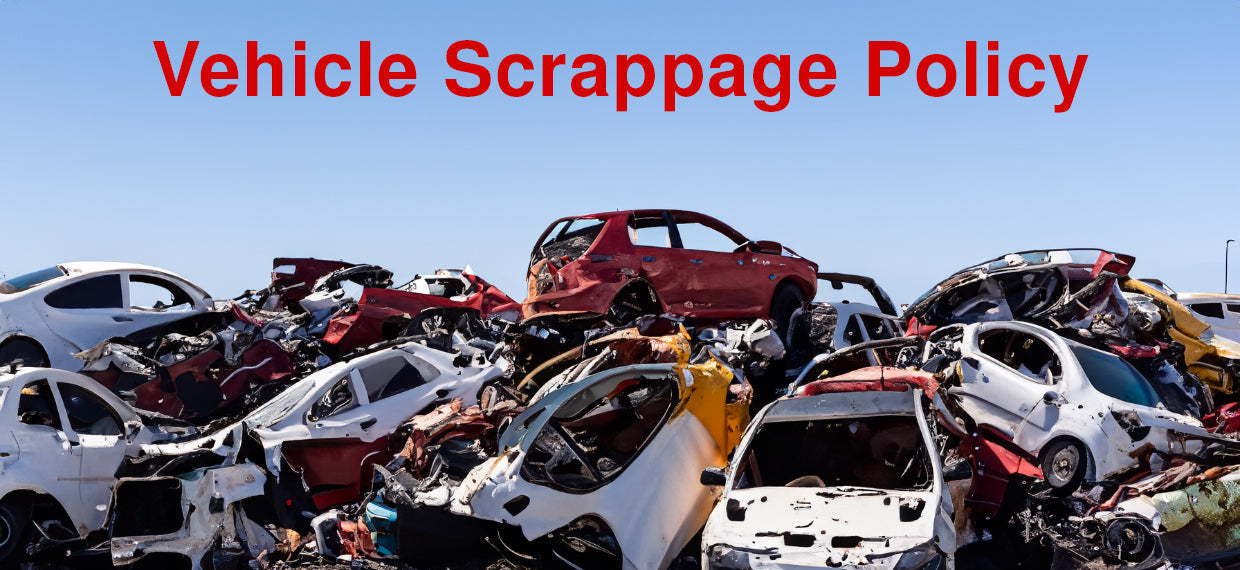New Vehicle Scrappage Policy - Buzzing the headlines

The wait since 2015 silence on 13 August, 2021 with the official announcement of India’s Vehicle Scrappage Policy or National Automobile Scrappage Policy. Government of India envisages it as a necessity born out of the Paris Climate Agreement. This apart, the policy is likely to shoot the bad omen hovering over the country’s automotive and manufacturing sectors.
Interestingly, the auto industry awaited the policy since 26 July, 2019, subsequent to proposed amendments to the Motor Vehicle Act to permit scrapping of vehicles past 15 years age.
Several countries including the US, Germany, Canada and China have previously introduced vehicle scrappage policies to advance their respective automotive industries and curb vehicular pollution. The case being the US, has employed the Car Allowance Rebate System (CARS), also called Cash for Clunkers program, which presents credit incentives on scrapping older vehicles and replacing them with new and more fuel-efficient vehicles.
Necessity - Mother of all policies
As a developing nation, India has a web of concerns around it. Interestingly, it is also in a state to mend or streamline its policy loopholes now. Taking this advantage, the government stands tall to realize its Paris Agreement commitment through the Vehicle Scrap page Policy. Clean and green mobility should be complimented by minimal strain on rising fuel import bill. The government intends to smoothly handle the suffering created by old vehicles in terms of pollution levels and fuel efficiency. It also intends to formalize informal vehicle scrapping industry and retrieve cheap material for automotive, steel and electronics industry. Another focal point is road and vehicular safety. One angle to the vehicle scrappage policy is its presentation as a Covid stimulus package, insisted primarily by the Original Equipment Manufacturers (OEMs) to broaden their demand.

What’s in the Box?
The policy sets an age of 15 years for commercial vehicles post which a failure in fitness test will imply vehicle de-registration. Private vehicles, aged 20 years or more, being unfit or their registration certificate not renewed may land up in de- registration group. The policy covers all vehicles of the Central Government, State Government, Municipal Corporation, Panchayats, State Transport Undertakings, Public Sector Undertakings and autonomous bodies with the Union and State Governments which may be de-registered and scrapped post 15 years from the registration date.
Vehicles exempted from the new policy are-Strong hybrids and electric vehicles, vehicles running on alternative fuels such as CNG, ethanol and LPG, farm and agricultural machinery such as tractors, tillers and harvesters.

Policy’s Voluntary Vehicle Fleet Modernization Program will encompass 450-500 automated vehicle fitness testing stations spread across India on PPP mode. Old vehicles to be examined at authorized Automated Fitness Center and will not be scrapped only on the basis of age. The criterion includes- emission test, braking system, safety components. The owner can resume the old vehicle as and when the fitness test is passed. However, re-registration charges will be sharper. In case, the vehicle fails to pass the test and the permitted retest, it will be admitted as an “End of Life Vehicle” (ELV).The entire policy is voluntary and a car over 20 years old does not by default get scrapped.
There will also be Registered Vehicle Scrapping Facility (RVSF) established across India. The Ministry of Road Transport and Highways will encourage public and private participation for beginning of such centers. Vehicle registration in RVSF will be through single window. The facility shall have to adhere to environmental and pollution norms. Scrapping centres shall deliver appropriate parking facility, de-pollution air, water and sound equipment and provision for disposal and management of hazardous waste.

Incentives for Vehicle Owner
The policy has substantial gains for vehicle owners which makes it quite catchy. The state governments may be notified to extend a road-tax rebate of up to 25% for personal vehicles and up to 15% for commercial vehicles. On purchase of new vehicle, manufacturers will extend a concession of 5% to buyers who hands over’ Scrapping Certificate’. Registration fees will also be waived off in such new purchases. Scrapping centres will offer 4-6% of ex-showroom price of new vehicle to the owner. These incentives will surely entice old vehicle owners. Emission reduction and enhanced fuel efficiency are the obvious grander motives.
However, few disincentives include-levy of Green Tax by States, increased registration fee for private vehicles, rise in renewal of fitness certification for commercial vehicles, Automatic deregistration of unfit vehicles
Significance of the Policy
Through the policy, government has eyed on multiple segments of economic growth. Expected rise in scrap yards would enable effective retrieval of reusable material from old vehicles. The prospective of recycle of 99% vehicle material can cut the raw material cost by as much as 40%. Additionally, import of scrap steel will see a decline. The entire formalized scrapping ecosystem will pull an investment of over Rs.10, 000 crores with the potential to generate thirty five thousand new jobs. The contraction in sale of heavy and medium commercial vehicles owing to bankruptcy of IL&FS and Covid -19 pandemic will be counteracted. The automobile industry will profit from cheaper production cost.
This apart, even the government’s strained purse will breathe a sigh of relief, with expected inflow of around Rs. 30,000 to 40,000 crores through GST. Also, the government’s vision of Circular Economy and waste to wealth campaign will reach the masses.
The policy is likely to cover 51 lakh Light Motor Vehicle (LMVs) that are above 20 years of age and another 34 lakh LMVs above 15 years of age. Thus it will have a pivotal role in streamlining vehicular population and phase out polluting vehicles.
- The policy will come into effect with tentative timelines as: October 1, 2021: Rules for fitness scrapping centres will be released
- April 1, 2022: Fitness testing for government and public-sector undertaking (PSU) vehicles
- April 1, 2023: Fitness testing for heavy commercial vehicles
- June 1, 2024: Fitness test rules to be laid out for other categories
The Roadblocks
The entire policy is infrastructure based. Thus, number and efficiency of testing and scrapping centres will have to rise; as such deficiency could paralyze the policy. Currently, India has only seven automated fitness test centers and two authorized scrappage centres, which is insufficient to satisfy the market. Even the de-registration process of vehicles in order to sell or scrap them gives nightmares to most owners.
Another question is how easily the states will surrender their road tax and registration which form a chunk of their revenue. Also, will the manufacturers easily shell out 5% discount on new vehicles against scrapping certificate?
The scrappage policy is designed with the correct intention. The policy is a collective step to minimize environmental hazards by building infrastructure for safe disposal and material recovery. It tries to keep a balance between all stakeholders. However, few challenges, if unanswered, will hover around policy implementation.
Leave A Reply
Your email address will not be published. Required fields are marked *
Products list

Yolo Fabric Car Seat Cover For Tata Curvv

Elegant Comfy Velvet Cushion & Neck Rest Car Pillow CU12








